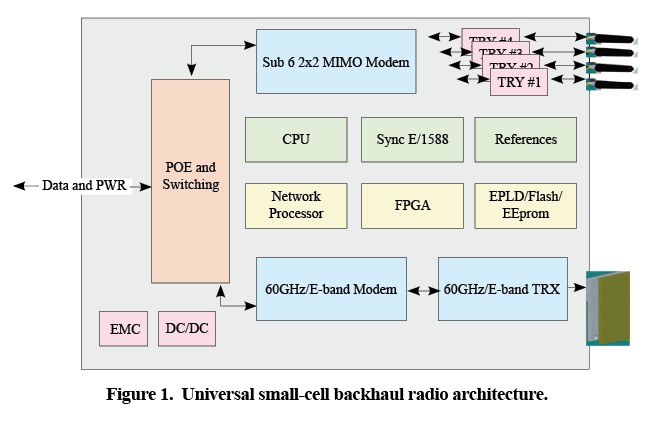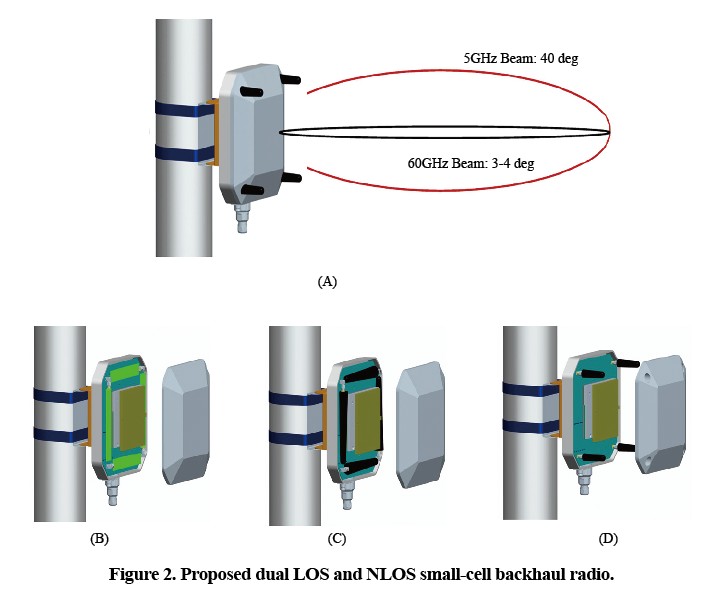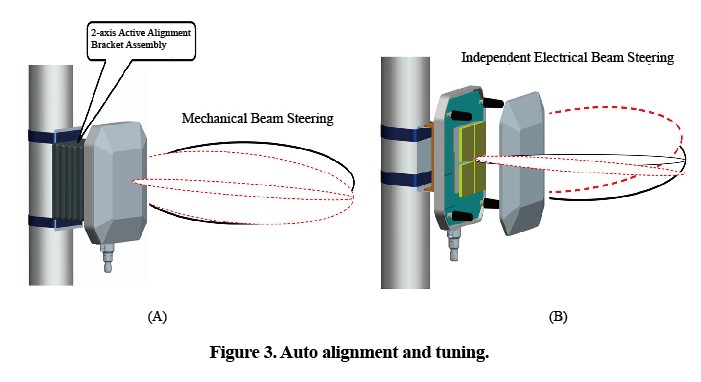A Universal Architecture for Small Cell Backhaul Radio

Background
Demand for mobile data is in soaring worldwide, and the boom is just beginning. Small cells, carrier WiFi, and backhaul are the top three solutions alongside backbone fiber networks that will support this mobile data explosion. Small-cell base stations will typically be deployed in addition to the existing macro layer. The key requirements for small-cell backhaul will be
● low total cost ownership (TCO)
● fast deployment and installation
● minimal regulation
● coordinated frequencies
● ubiquitous coverage in hotspots and in line-of-sight (LOS) and non line of sight (NLOS) environments.
Backhaul is a key challenge. The top three small-cell backhaul candidates are fiber, NLOS sub 6 GHz MIMO, and millimeter wave point-to-point (PtP) LOS radios at 60 GHz or E-bands.
There is no single solution, and the combination of these technologies depends on cell location, coverage size, and capacity requirements. Here, we describe a universal architecture for small-cell backhaul radio when the backhaul needs to use the wireless connection.
Universal Small-Cell Backhaul Radio Architecture
The top three requirements for small-cell backhaul are low cost, easy installation and LOS and NLOS coverage. If the link distance is a maximum of a few hundred meters, maximum availability is 99.99%, and street-level light poles and utility poles are used, 5 GHz and 60 GHz are the most effective bands, respectively, for NLOS and LOS small-cell backhaul applications. 5 GHz is a sub 6 GHz band, and 60 GHz is an unlicensed band that has unique oxygen absorption characteristics for frequency reuse. It also provides wide spectrum availability.

Fig. 1 shows a universal NLOS and LOS small-cell backhaul radio architecture. The data and DC power are obtained directly from the small cell. There are two separate data channels: one goes to a sub 6 GHz NLOS channel, and the other goes to a 60 GHz/E-band LOS channel. In normal operation, the sub 6 GHz NLOS channel and 60 GHz/E-band LOS channel work simultaneously and provide maximum throughput. If the sub 6 GHz or 60 GHz/E-band channel does not work because of in-band interference, blockage, multipath fading, or hardware failure, the system provides automatic hitless switching. A universal small-cell backhaul needs to have the following key features:
● fully integrated dual-band solution
● flat antenna for 60 GHz band or E-band
● dipole or microstrip antenna for sub 6 GHz band
● auto mechanical or electrical tuning with auto alignment
● combined NLOS and LOS for various coverage needs
● multi-gigabits-per-second hitless throughput
● carrier Ethernet switching to support MPLS/MPSL-TP standards, QoS scheduling, protection, and OAM
● support for Sync E or IEEE 1588v2 for precision timing transport
● power over Ethernet (POE).
Both 5 GHz and 60 GHz are unlicensed bands and are available in all countries. 5 GHz time division duplex (TDD) can support up to 600 Mbps throughput with advanced 4 × 4 MIMO, and 60 GHz full duplex FDD or TDD can support up to 10 Gbps throughput. Fig. 2 shows the proposed small-cell backhaul. Fig. 2 (a) shows a concept of this dual LOS and NLOS combined radio. 5 GHz NLOS uses either four dipoles (folded or unfolded) or four microstrip antennas, and 60 GHz LOS uses flat antenna, as shown in Fig. 2 (b), (c) and (d). The 5 GHz NLOS MIMO provides a typical antenna beamwidth of about 40 degrees, and 60 GHz point-to-point LOS provides a typical beamwidth of three to four degrees.

Installation is one of the most important aspects of small-cell stations and backhaul radios because of the potential costs involved in mounting, installation, maintenance, and coverage. Fig. 3 shows a mechanical auto alignment concept. Two dimensional azimuth and elevation auto mechanical tuning is achieved by using two separate step motors that are integrated in the back of the radio mounting mechanics. Mechanical alignment greatly decreases installation time and increases link availability and liability due to weather, environment, multipath and other factors. The radio provides the required DC and control signals to the tunable mounting mechanism so that this mechanism can automatically align the radio and enhance the radio’s performance during installation and operation.

If the cost of the 60 GHz CMOS module is further reduced and the transceiver is developed, dual-band radios will inevitably use phase array or digital beamforming techniques at 60 GHz, as shown in Fig. 3 (b). With either phase array or digital beamforming techniques at 60 GHz, the radio will be capable of independent electronic beam tuning for both 5 GHz NLOS and 60 GHz signals.
Furthermore, the dual-band concept can be extended to any NLOS and LOS frequency combination, such as 2.4 GHz, 2.6 GHz or 3.4 GHz NLOS combined with E-band LOS.
The dual-band concept can be extended to triple band offering or selective switching bands in NLOS and can be combined with either 60 GHz or E-band LOS.
Summary
A universal LOS and NLOS tunable small-cell back radio architecture provides
● the flexibility to use unlicensed bands for installation and network build-out in international markets.
● flexible backhaul solutions when there is no fiber available and the small-cell station needs wireless connectivity. (The proposed package provides the solutions for both LOS and NLOS environment.)
● a compact flat antenna that avoids the traditional parabolic perception of a public antenna. A flat antenna also provides a clean integrated solution so that a small-cell network can be a part of the future digital infrastructure of a city.
● mechanical tuning, which greatly reduces the installation requirements and alignment difficulties. This significantly increases link availability.
● a development path for electronic turning capability using phase array or digital beam forming at 60 GHz when CMOS technologies get mature.
● a TDD/FDD radio to support combined NLOS and LOS traffic and also to support hitless switching when one of the paths has performance or LOS problems. This greatly increases system availability and liability.